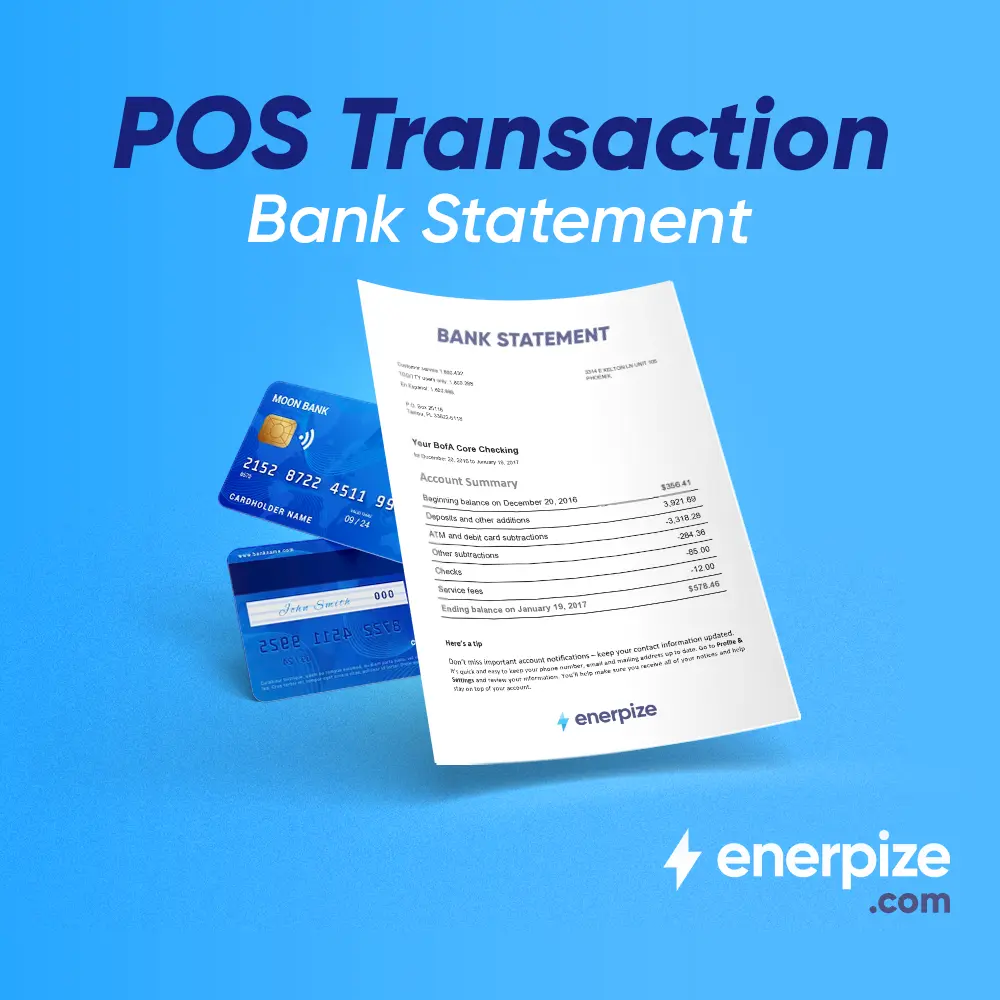Author : Enerpize Team
How To Read an Income Statement: A Comprehensive Guide

Financial statements are fundamental to accounting operations management. All businesses need a range of financial statements, sheets, and reports to assess current and future financial performance, position, and overall company valuation. The income statement is one such statement.
In addition to the balance sheet and cash flow statement, the income statement provides financial planners, controllers, and auditors with insights into how a given company operates, what gains or losses are made, what future prospects are, and more.
The income statement may need to be simplified for startups, business owners, and entrepreneurs. Understanding how an income statement works may be problematic for those with little or no accounting knowledge.
To set records straight, a more solid understanding of an income statement, what makes up an income statement, and how to read one is required.
This post aims to clarify what an income statement means and how business owners, executive managers, and entrepreneurs could use one.
Key Takeaways
- Income statements are critical tools for tracking a company’s financial health, showing revenues, expenses, gains, and losses over a specific period.
- The main components of an income statement include operating and non-operating revenue, gains, primary and secondary expenses, and losses.
- Operating revenue comes from core business activities, while non-operating revenue stems from sources like interest or leasing.
- Primary expenses relate to direct operations (e.g., payroll, rent), whereas secondary expenses arise from indirect costs like loan interest.
- Gains and losses typically result from one-time events, such as selling assets at a profit or loss.
- Two analysis methods exist: vertical analysis compares items as percentages of total revenue; horizontal analysis tracks changes over multiple periods.
- Income can also be calculated using single-step or multiple-step methods, with the latter breaking down profitability into gross, operating, and net income stages.
- Reading an income statement involves tracing key figures, like gross profit, operating income, tax expense, and final net income.
What is an Income Statement?
The income statement records a company’s revenue, expenses, gains, and losses over a given reporting period. Also known as a Profit and Loss (P&L) statement, income statements provide detailed information about a company’s overall operational efficiency, management robustness, and cost management effectiveness.
As such, income statements are indispensable for all stakeholders to obtain a comprehensive picture of a given company over a specific reporting period. No financial statement can provide detailed information about a company’s revenue, expenses, gains, and losses as income statements do.
Read More: How To Prepare An Income Statement: Steps & How To Automate
Given how vital income statements are, how do you analyze and read an income statement as a business owner or executive manager?
But first is first. You first need to learn what an income statement is made up of.
Income Statement Components
Typically, an income statement is made up of six components:
- Operating Revenue.
- Non-Operating Revenue.
- Gains.
- Primary-Activity Expenses.
- Secondary-Activity Expenses.
- Losses as Expenses.
The following is a more detailed discussion of each.
Operating Revenue
Operating revenue refers to all revenue a company realizes—in cash, non-cash, or cash equivalents—from direct or primary business activities. For example, if a company sells products or services, revenues generated from such sales are considered operating revenue.
Non-Operating Revenue
Predictably, non-core or indirect business activities are considered non-operating revenue. Indirect business activities that result in income generation include:
- Interest on bank-deposited capital.
- Property leasing.
- Mergers and acquisitions.
- Royalties and licensing.
- On-property advertising.
- Interest on dividends.
Depending on size and scope, non-operating revenue could surpass operating revenue, particularly for global companies like Apple.
Gains
Also called sundry or miscellaneous income, gains are a company's revenue stream from selling long-term assets. Unlike non-operating revenue, which is recurring, gains are usually one-time non-core business activities. These include selling property, equipment, or an affiliate subsidiary or practice.
However, a distinction should be made between revenue as a stream of income and receipt as evidence of income. In essence, revenue is a promise made (but which has yet to be fulfilled) to pay a company in return for products or services purchased. However, a receipt is evidence of a reported payment where money is actually received. A seller may, for example, issue a debit note to a buyer who is yet to pay later, depending on his credit reputation.
Primary-Activity Expenses
These are expenses a company incurs to generate primary activity or operating revenue. Generally, primary-activity expenses include COGS, depreciation or amortization, R&D, and selling, general, and administrative (SG&A) expenses. Common examples include:
- Payroll
- Lease
- Utilities
- Repair/Maintenance
- Taxes
- Travel
- Accommodation
Read Also: How to Track Business Expenses?
Secondary-Activity Expenses
These are mirror records of non-operating revenue. That is, while non-operating revenue records revenue streams from non-core business activities, secondary-activity expenses record expenses from non-core business activities, such as interest on loans or debt.
Losses as Expenses
These are mirror records of gains. That is, while gains record revenue a company realizes from selling long-term assets, usually on a one-time basis, losses as expenses record expenses a company incurs from assets sold at a loss, also usually on a one-time basis. Further, losses as expenses may include unexpected or unusual costs, such as substantial property damage or litigation costs.
Download Now: Income Statement Template Excel & Google Sheets
Now that you have learned what an income statement consists of, a next intuitive step is to learn how to analyze one.
Income Statement Analyzing
The income statement is created mathematically using a standard formula as follows:
Net Income = [Revenue + Gains] - [Expenses + Losses]
That is, a company’s net income is calculated by subtracting all outgoing costs (expenses + losses) from incoming income (revenue + gains), where “Revenue” refers to operating and non-operating revenue and “Expenses” refers to primary-activity expenses and secondary-activity expenses.
What follows is an account of various methods used to calculate a company’s net income.
Vertical/Horizontal Analysis
Vertical Analysis
The vertical analysis method lists each line item as a percentage of a reference, or base, figure within a current reporting period. Instead of listing line items as actual values, income statements created using a vertical analysis present numbers as percentages of gross sales.
The vertical analysis method helps compare a company’s financial statements over a given reporting period, across industries, and between companies, but it cannot readily provide financial planners, controllers, and auditors with immediate financial information as a horizontal analysis does.
Horizontal Analysis
In contrast, a horizontal analysis lists each line item in an income statement as a percentage of a reference figure across multiple reporting periods. Unlike a vertical analysis, a horizontal analysis approach to financial analysis is consistent with GAAP requirements.
Horizontal analysis is more important for financial planners and investors than vertical analysis. Specifically, a vertical analysis provides senior internal financial controllers and external analysts with market-wide comparisons between a given company and comparable companies over multiple reporting periods.
Read more: Comparative Income Statement: Importance & Preparation
Alternatively, a company’s net income can be accounted for using single-step and multiple-step methods as follows:
Single-Step/Multiple-Step Method
Single-Step Approach
The single-step method is done as shown above by adding all revenue, gains, expenses, and losses.
Multiple-Step Approach
The multiple-step method involves more complex calculations, where revenue, gains, expenses, and losses are much more diversified. The profitability of big companies or companies operating globally is typically reported in four phases: gross, operating, pretax, and post-tax. This four-phased profitability calculation helps break down all components into more manageable and analyzable accounting activities.
That said, how could you eventually read an income statement as in real business situations?
How to Read an Income Statement?
A practical example is needed to show you how to read an income statement. Here is one:
| Category | Amount ($) |
| Revenue | |
| Sales Revenue | 500,000 |
| Other Revenue (e.g., interest) | 10,000 |
| Total Revenue | 510,000 |
| Cost of Goods Sold (COGS) | |
| Raw Materials | 120,000 |
| Labor Costs | 80,000 |
| Manufacturing Overhead | 50,000 |
| Total COGS | 250,000 |
| Gross Profit | 260,000 |
| Operating Expenses | |
| Selling Expenses | 30,000 |
| General & Administrative | 50,000 |
| Research & Development | 20,000 |
| Total Operating Expenses | 100,000 |
| Operating Income | 160,000 |
| Other Income & Expenses | |
| Interest Income | 5,000 |
| Interest Expense | (3,000) |
| Net Other Income/Expenses | 2,000 |
| Income Before Taxes | 162,000 |
| Income Tax Expense | (32,400) |
| Net Income | 129,600 |
The following sections explain how to read each primary section in ABC’s income statement.
Revenue Section
The Revenue Section shows ABC’s gross margin was $260,000 for the fiscal year ending December 31, 2023. This margin is calculated by subtracting the cost of revenue, COGS, ($250,000) from the total revenue ($10,000). That means ABC spent 49% of its total revenue to generate $510,000.
Operating Expenses
Operating expenses are additional expenses ABC incurs and are subtracted from its Total Revenue. Specifically, ABC spent $100,000 on Selling Expenses ($30,000), General & Administrative ($50,000), Research & Development ($20,000). Subtracting ABC’s Operating Expenses ($100,000) from its Total Revenue ($510,000) leads to an Operating Income of $160,000, which is used to calculate ABC’s net income according to the formula as mentioned earlier under “Income Statement Analyzing.”
Other Income & Expenses
These are income ($5000) and expense ($3000) line items from non-operating revenue and secondary-activity expenses. The net of adding both equals $2000 in positive value, as shown next to Net Other Income/Expenses.
Gains & Losses
The above example does not show gains or losses made by ABC. That means our calculation moves on to ABC’s pre-tax income.
Income Before Taxes
This is calculated by adding Net Other Income/Expenses to Operating Income to get ABC’s Income Before Tax of $162,000.
Income Tax Expense
This covers all expenses incurred by ABC to pay income tax, including payroll, sales, and excise taxes. The above example shows an Income Tax Expense of $32,400.
Net Income
This is where ABC’s Net Income can be calculated by subtracting Income Tax Expense ($32,400) from Income Before Taxes ($160,000) to get $129,600.
That said, as companies grow in size and operations, calculating their net income can become more complicated as more entries are accounted for based on broader business activities.
Read Also:
Contribution Income Statement: A Comprehensive Guide
Streamline Income Statement With Enerpize
Enerpize is a leading online accounting software developed with accounting operations management front and center. Opting for Enerpize has helped many companies scale and streamline income statements smoothly, quickly, and compliantly.
With multiple features in place, Enerpize is best positioned to help businesses:
- List expenses and revenue from any device or platform anywhere at any time.
- Custom-display revenue, expenses, net income, and more to generate shareable and printable invoices, set date ranges, and auto-calculate net profit.
- Calculate tax options (GST, VAT, EXP, etc.) per jurisdiction or reporting period.
- Track operation expenses to control costs and calculate profitability per product, segment, or department.
- Create custom accounts to map a range of transactions onto your general ledger.
- Generate lifetime company statements and reports.
- Maintain accurate records of all transactions to prepare auditable and reportable financial data for automated or manual statements and sheets.
- Auto-adjust Enerpize settings as and when required to create easy-to-generate recurring expense daily, weekly, or monthly records.
- Perform cost-effective asset development, operationalization, upgrade, and disposal to enhance asset acquisition.
- Use a multi-currency setup to manage payments and comply with tax regulations in multiple jurisdictions.
Try Enerpize out to get your accounting operations management on its feet - and to compete.
Final Thoughts
Income statements are indispensable for every business to calculate, manage, and project revenue, expenses, gains, and losses.
As a business owner or executive manager, you must learn how to analyze and read your income statement - even when you have your in-house accountant.
To analyze an income statement, you may opt for a vertical/horizontal approach where each line item is listed as a percentage of a reference figure within a current reporting period (vertical analysis) or across periods (horizontal analysis).
You may also opt for a single-step or multiple-step approach, in which all revenue, gains, expenses, and losses are added straightforwardly (single-step method), or more complex line items involving a wider range of revenues, expenses, gains, and losses are included (multiple-step method).
The bottom line is, income statements are used not only by immediate stakeholders such as accountants or financial controllers but also by investors, upper management, and creditors to decide on more strategic financial and market matters.
Choose your accounting management partner carefully so your business outperforms the competition.
Reading income statement is easy with Enerpize.
Try our accounting module to create and analyze financial statements smoothly.








